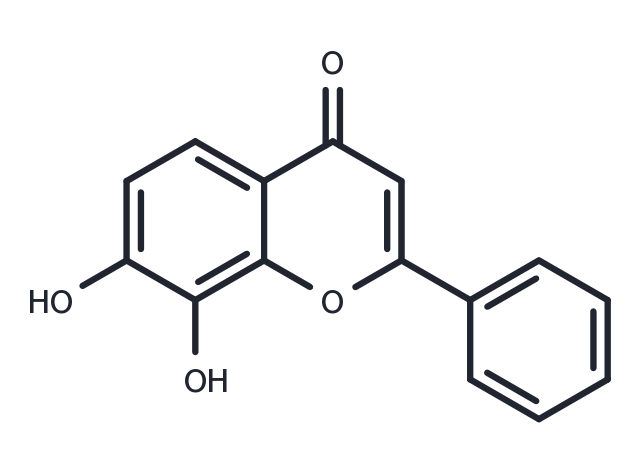Powder: -20°C for 3 years | In solvent: -80°C for 1 year


7,8-Dihydroxyflavone (7,8-DHF) is a naturally-occurring flavone and exist in Tridax procumbens, Godmania aesculifolia, and primula tree leaves.

| Pack Size | Availability | Price/USD | Quantity |
|---|---|---|---|
| 10 mg | In stock | $ 30.00 | |
| 50 mg | In stock | $ 68.00 | |
| 100 mg | In stock | $ 90.00 | |
| 1 mL * 10 mM (in DMSO) | In stock | $ 54.00 |



| Description | 7,8-Dihydroxyflavone (7,8-DHF) is a naturally-occurring flavone and exist in Tridax procumbens, Godmania aesculifolia, and primula tree leaves. |
| Targets&IC50 | TrkB receptor:320 nM(Kd) |
| In vitro | 7,8-DHF is one of the positive compounds that specifically activate TrkB, but not TrkA or TrkC, at a concentration of 250 nM. In addition to cortical and hippocampal neurons, 7,8-DHF also protects other cell types including the RGC (retinal ganglion cells) and PC12 cells from excitotoxic and oxidative stress-induced apoptosis and cell death. Thus, it has neuroprotective properties[1]. |
| In vivo | 7,8-Dihydroxyflavone is a bioavailable chemical that can pass through the BBB to provoke TrkB and its downstream PI3K/Akt and MAPK activation in mouse brain upon intraperitoneal or oral administration. 7,8-DHF promotes the survival and reduces apoptosis in cortical neurons of traumatic brain injury as administration of 7,8-DHF at 3 h post-injury reduces brain tissue damage via the PI3K/Akt pathway. Its treatment does not induce any apparent toxicity in mice and is not toxic to the mice during the chronic treatment. 7,8-DHF displays robust therapeutic efficacy toward Alzheimer's disease and inhibits obesity through activating muscular TrkB[1]. |
| Cell Research | PC12 cells are seeded in 96-well plates at 104/well. After pretreatment with 7,8-DHF (1-25 μM) for 1 h, the cells are exposed to 6-OHDA (100 μM) for subsequent 24 h. The PI3k inhibitor LY294002 or MEK inhibitor PD98059 is added 30 min before 7,8-DHF treatment. At the end of the experiment, PC12 cells are incubated with 20 μl of MTT solution (5 mg/ml in PBS) for 4 h at 37 ?C. The dark blue formazan product due to the reduction of MTT is dissolved in 150 μl of DMSO, and the absorbance at 570 nm is recorded with a microplate reader. The viability is expressed as the percentage of the untreated control cells. (Only for Reference) |
| Source |
| Synonyms | 7,8-DHF |
| Molecular Weight | 254.24 |
| Formula | C15H10O4 |
| CAS No. | 38183-03-8 |
Powder: -20°C for 3 years | In solvent: -80°C for 1 year
H2O: < 1 mg/mL (insoluble or slightly soluble)
DMSO: 47 mg/mL (184.9 mM)
Ethanol: 1 mg/mL (3.93 mM)
You can also refer to dose conversion for different animals. More
bottom
Please see Inhibitor Handling Instructions for more frequently ask questions. Topics include: how to prepare stock solutions, how to store products, and cautions on cell-based assays & animal experiments, etc.
7,8-Dihydroxyflavone 38183-03-8 Apoptosis Tyrosine Kinase/Adaptors Trk receptor Trk Receptor Inhibitor Tropomyosin related kinase receptor 7,8-DHF inhibit 7,8Dihydroxyflavone 7,8 Dihydroxyflavone inhibitor
